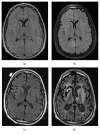Evolution of Cerebral Atrophy in a Patient with Super Refractory Status Epilepticus Treated with Barbiturate Coma
- PMID: 28182114
- PMCID: PMC5274686
- DOI: 10.1155/2017/9131579
Evolution of Cerebral Atrophy in a Patient with Super Refractory Status Epilepticus Treated with Barbiturate Coma
Abstract
Introduction. Status epilepticus is associated with neuronal breakdown. Radiological sequelae of status epilepticus include diffusion weighted abnormalities and T2/FLAIR cortical hyperintensities corresponding to the epileptogenic cortex. However, progressive generalized cerebral atrophy from status epilepticus is underrecognized and may be related to neuronal death. We present here a case of diffuse cerebral atrophy that developed during the course of super refractory status epilepticus management despite prolonged barbiturate coma. Methods. Case report and review of the literature. Case. A 19-year-old male with a prior history of epilepsy presented with focal clonic seizures. His seizures were refractory to multiple anticonvulsants and eventually required pentobarbital coma for 62 days and midazolam coma for 33 days. Serial brain magnetic resonance imaging (MRI) showed development of cerebral atrophy at 31 days after admission to our facility and progression of the atrophy at 136 days after admission. Conclusion. This case highlights the development and progression of generalized cerebral atrophy in super refractory status epilepticus. The cerebral atrophy was noticeable at 31 days after admission at our facility which emphasizes the urgency of definitive treatment in patients who present with super refractory status epilepticus. Further research into direct effects of therapeutic coma is warranted.
Conflict of interest statement
The authors declare that they have no competing interests.
Figures

Similar articles
-
Observed medical and surgical complications of prolonged barbiturate coma for refractory status epilepticus.Ther Adv Drug Saf. 2016 Oct;7(5):195-203. doi: 10.1177/2042098616659414. Epub 2016 Jul 18. Ther Adv Drug Saf. 2016. PMID: 27695621 Free PMC article.
-
Progressive Brain Atrophy in Super-refractory Status Epilepticus.JAMA Neurol. 2016 Oct 1;73(10):1201-1207. doi: 10.1001/jamaneurol.2016.1572. JAMA Neurol. 2016. PMID: 27533350
-
Midazolam fails to prevent neurological damage in children with convulsive refractory febrile status epilepticus.Pediatr Neurol. 2014 Jul;51(1):78-84. doi: 10.1016/j.pediatrneurol.2014.02.021. Epub 2014 Mar 4. Pediatr Neurol. 2014. PMID: 24830769
-
High dose phenobarbitone coma in pediatric refractory status epilepticus; a retrospective case record analysis, a proposed protocol and review of literature.Brain Dev. 2018 Apr;40(4):316-324. doi: 10.1016/j.braindev.2017.11.009. Epub 2018 Jan 3. Brain Dev. 2018. PMID: 29306558 Review.
-
Pearls and Pitfalls of Introducing Ketogenic Diet in Adult Status Epilepticus: A Practical Guide for the Intensivist.J Clin Med. 2021 Feb 22;10(4):881. doi: 10.3390/jcm10040881. J Clin Med. 2021. PMID: 33671485 Free PMC article. Review.
Cited by
-
Differentiation of Epileptic Brain Abnormalities among Neurological Patients at Taif Region Using MRI.Int J Clin Pract. 2023 Nov 11;2023:8783446. doi: 10.1155/2023/8783446. eCollection 2023. Int J Clin Pract. 2023. PMID: 38020535 Free PMC article.
-
Comparison of volume of the forebrain, subarachnoid space and lateral ventricles between dogs with idiopathic epilepsy and controls using a stereological approach: Cavalieri's principle.Canine Med Genet. 2021 Mar 10;8(1):3. doi: 10.1186/s40575-021-00101-6. Canine Med Genet. 2021. PMID: 33691781 Free PMC article.
-
Super-Refractory Status Epilepticus Treated with High Dose Perampanel: Case Series and Review of the Literature.Case Rep Crit Care. 2019 Sep 2;2019:3218231. doi: 10.1155/2019/3218231. eCollection 2019. Case Rep Crit Care. 2019. PMID: 31565443 Free PMC article.
References
Publication types
LinkOut - more resources
Full Text Sources
Other Literature Sources

